Which Of The Following Are Distinguishing Features Of Mammals From Other Animals?
Vertebrates
155 Mammals
Learning Objectives
By the terminate of this department, you will be able to do the following:
- Proper noun and describe the distinguishing features of the three main groups of mammals
- Describe the likely line of evolutionary descent that produced mammals
- List some derived features that may have arisen in response to mammals' demand for abiding, high-level metabolism
- Identify the major clades of eutherian mammals
Mammals, comprising about v,200 species, are vertebrates that possess hair and mammary glands. Several other characteristics are distinctive to mammals, including certain features of the jaw, skeleton, integument, and internal anatomy. Modern mammals belong to three clades: monotremes, marsupials, and eutherians (or placental mammals).
Characteristics of Mammals
The presence of hair, composed of the protein keratin, is ane of the most obvious characteristics of mammals. Although it is not very extensive or obvious on some species (such as whales), hair has many important functions for most mammals. Mammals are endothermic, and pilus traps a boundary layer of air close to the torso, retaining rut generated by metabolic activeness. Along with insulation, hair can serve as a sensory mechanism via specialized hairs called vibrissae, better known as whiskers. Vibrissae attach to fretfulness that transmit data virtually tactile vibration produced by sound sensation, which is particularly useful to nocturnal or burrowing mammals. Hair can also provide protective coloration or be part of social signaling, such as when an animal'due south hair stands "on end" to warn enemies, or perchance to brand the mammal "wait bigger" to predators.
Unlike the skin of birds, the integument (skin) of mammals, includes a number of different types of secretory glands. Sebaceous glands produce a lipid mixture chosen sebum that is secreted onto the pilus and peel, providing water resistance and lubrication for hair. Sebaceous glands are located over near of the body. Eccrine glands produce sweat, or perspiration, which is mainly composed of water, but also contains metabolic waste products, and sometimes compounds with antibody action. In well-nigh mammals, eccrine glands are limited to certain areas of the body, and some mammals practise not possess them at all. Still, in primates, especially humans, sweat glands are located over most of the body surface and figure prominently in regulating the torso temperature through evaporative cooling. Apocrine glands, or scent glands, secrete substances that are used for chemical advice, such as in skunks. Mammary glands produce milk that is used to feed newborns. In both monotremes and eutherians, both males and females possess mammary glands, while in marsupials, mammary glands have been found only in some opossums. Mammary glands probable are modified sebaceous or eccrine glands, but their evolutionary origin is not entirely articulate.
The skeletal organisation of mammals possesses many unique features. The lower jaw of mammals consists of just one bone, the dentary, and the jaw hinge connects the dentary to the squamosal (flat) part of the temporal bone in the skull. The jaws of other vertebrates are composed of several bones, including the quadrate bone at the dorsum of the skull and the articular bone at the back of the jaw, with the jaw connected between the quadrate and articular bones. In the ear of other vertebrates, vibrations are transmitted to the inner ear by a single os, the stapes. In mammals, the quadrate and articular bones have moved into the middle ear ((Figure)). The malleus is derived from the articular bone, whereas the incus originated from the quadrate bone. This organisation of jaw and ear bones aids in distinguishing fossil mammals from fossils of other synapsids.
Mammalian ear bones. Bones of the mammalian middle ear are modified from bones of the jaw and skull in reptiles. The stapes is found in other vertebrates (east.m., the columella of birds) whereas in mammals, the malleus and incus are derived from the articular and quadrate bones, respectively. (credit: NCI)
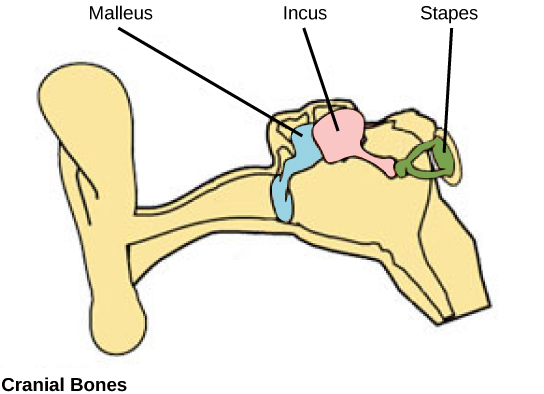
The adductor muscles that close the jaw comprise two major muscles in mammals: the temporalis and the masseter. Working together, these muscles permit up-and-downward and side-to-side movements of the jaw, making chewing possible—which is unique to mammals. Nearly mammals have heterodont teeth, meaning that they have different types and shapes of teeth (incisors, canines, premolars, and molars) rather than but one type and shape of tooth. Nearly mammals are too diphyodonts, meaning that they have two sets of teeth in their lifetime: deciduous or "baby" teeth, and permanent teeth. Most other vertebrates with teeth are polyphyodonts, that is, their teeth are replaced throughout their entire life.
Mammals, like birds, possess a four-chambered heart; even so, the hearts of birds and mammals are an instance of convergent development, since mammals clearly arose independently from different groups of tetrapod ancestors. Mammals also accept a specialized group of cardiac cells (fibers) located in the walls of their right atrium chosen the sinoatrial node, or pacemaker, which determines the rate at which the eye beats. Mammalian erythrocytes (red blood cells) do not have nuclei, whereas the erythrocytes of other vertebrates are nucleated.
The kidneys of mammals have a portion of the nephron chosen the loop of Henle or nephritic loop, which allows mammals to produce urine with a high concentration of solutes—higher than that of the claret. Mammals lack a renal portal organization, which is a organization of veins that moves blood from the hind or lower limbs and region of the tail to the kidneys. Renal portal systems are present in all other vertebrates except jawless fishes. A urinary bladder is nowadays in all mammals.
Different birds, the skulls of mammals take two occipital condyles, bones at the base of the skull that clear with the start vertebra, as well equally a secondary palate at the rear of the pharynx that helps to split up the pathway of swallowing from that of breathing. Turbinate bones (chonchae in humans) are located forth the sides of the nasal cavity, and help warm and moisten air as it is inhaled. The pelvic bones are fused in mammals, and there are typically seven cervical vertebrae (except for some edentates and manatees). Mammals have movable eyelids and fleshy external ears (pinnae), quite dissimilar the naked external auditory openings of birds. Mammals besides have a muscular diaphragm that is lacking in birds.
Mammalian brains besides have sure characteristics that differ from the brains of other vertebrates. In some, only not all mammals, the cerebral cortex, the outermost part of the cerebrum, is highly convoluted and folded, allowing for a greater surface area than is possible with a polish cortex. The optic lobes, located in the midbrain, are divided into two parts in mammals, while other vertebrates possess a single, undivided lobe. Eutherian mammals also possess a specialized structure, the corpus callosum, which links the two cerebral hemispheres together. The corpus callosum functions to integrate motor, sensory, and cognitive functions between the left and right cerebral cortexes.
Development of Mammals
Mammals are synapsids, meaning they have a single, ancestrally fused, postorbital opening in the skull. They are the but living synapsids, as earlier forms became extinct by the Jurassic period. The early on non-mammalian synapsids can exist divided into two groups, the pelycosaurs and the therapsids. Within the therapsids, a group called the cynodonts are thought to have been the ancestors of mammals ((Figure)).
Cynodont. Cynodonts ("domestic dog teeth"), which showtime appeared in the Tardily Permian flow 260 million years ago, are thought to be the ancestors of modern mammals. Holes in the upper jaws of cynodonts suggest that they had whiskers, which might too indicate the presence of hair. (credit: Nobu Tamura)
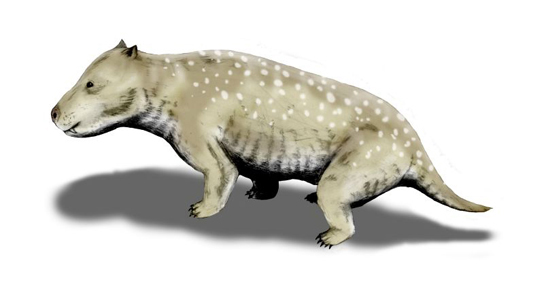
As with birds, a key characteristic of synapsids is endothermy, rather than the ectothermy seen in many other vertebrates (such every bit fish, amphibians, and nigh reptiles). The increased metabolic rate required to internally modify body temperature probable went hand-in-manus with changes to certain skeletal structures that improved food processing and ambulation. The later synapsids, which had more evolved characteristics unique to mammals, possess cheeks for belongings food and heterodont teeth, which are specialized for chewing, mechanically breaking down nutrient to speed digestion, and releasing the energy needed to produce oestrus. Chewing as well requires the ability to exhale at the aforementioned time, which is facilitated by the presence of a secondary palate (comprising the bony palate and the posterior continuation of the soft palate). The secondary palate separates the area of the oral fissure where chewing occurs from the area above where respiration occurs, allowing animate to proceed uninterrupted while the animal is chewing. A secondary palate is non establish in pelycosaurs but is present in cynodonts and mammals. The jawbone besides shows changes from early synapsids to subsequently ones. The zygomatic curvation, or cheekbone, is present in mammals and advanced therapsids such equally cynodonts, just is not present in pelycosaurs. The presence of the zygomatic arch suggests the presence of masseter muscles, which shut the jaw and function in chewing.
In the appendicular skeleton, the shoulder girdle of therian mammals is modified from that of other vertebrates in that it does not possess a procoracoid bone or an interclavicle, and the scapula is the dominant bone.
Mammals evolved from therapsids in the late Triassic period, as the primeval known mammal fossils are from the early Jurassic menses, some 205 million years agone. Ane group of transitional mammals was the morganucodonts, small nocturnal insectivores. The jaws of morganucodonts were "transitional," with features of both reptilian and mammalian jaws ((Figure)). Like modernistic mammals, the morganucodonts had differentiated teeth and were diphyodonts. Mammals first began to diversify in the Mesozoic era, from the Jurassic to the Cretaceous periods. Even some small gliding mammals appear in the fossil record during this fourth dimension period. Even so, most of the Jurassic mammals were extinct by the end of the Mesozoic. During the Cretaceous flow, some other radiation of mammals began and continued through the Cenozoic era, virtually 65 million years ago.
A morganucodont. This morganucodont Megazotrodon, an extinct basal mammal, may have been nocturnal and insectivorous. Inset: Jaw of a morganucodont, showing a double hinge, one between the dentary and squamosal and i between the articular (yellowish) and quadrate (bluish) bones. In living mammals, the articular and quadrate bones accept been incorporated into the middle ear. (Credit: By Nordelch [Megazostrodon Natural History Museum] Wikimedia Commons. Credit inset: Mod from Philcha. https://commons.wikimedia.org/w/index.php? curid=3631949)
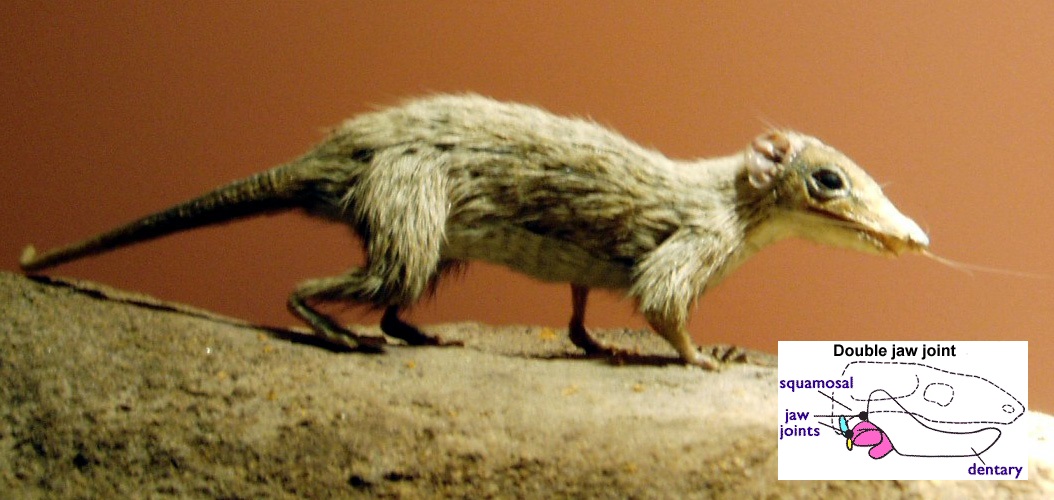
Living Mammals
There are three major groups of living mammals: monotremes (prototheria), marsupials (metatheria), and placental (eutheria) mammals. The eutherians and the marsupials together comprise a clade of therian mammals, with the monotremes forming a sis clade to both metatherians and eutherians.
There are very few living species of monotremes: the platypus and four species of echidnas, or spiny anteaters. The leathery-beaked platypus belongs to the family Ornithorhynchidae ("bird beak"), whereas echidnas belong to the family Tachyglossidae ("gummy tongue") ((Figure)). The platypus and one species of echidna are found in Commonwealth of australia, and the other species of echidna are found in New Guinea. Monotremes are unique amongst mammals because they lay eggs, rather than giving birth to live immature. The shells of their eggs are not like the hard shells of birds, simply have a leathery trounce, similar to the shells of reptile eggs. Monotremes retain their eggs through well-nigh two-thirds of the developmental menstruation, and then lay them in nests. A yolk-sac placenta helps support development. The babies hatch in a fetal land and complete their development in the nest, nourished past milk secreted by mammary glands opening directly to the skin. Monotremes, except for young platypuses, do non have teeth. Body temperature in the iii monotreme species is maintained at nigh thirty°C, considerably lower than the average body temperature of marsupial and placental mammals, which are typically between 35 and 38°C.
Egg-laying mammals. (a) The platypus, a monotreme, possesses a leathery beak and lays eggs rather than giving nascency to live young. (b) The echidna is another monotreme, with long hairs modified into spines. (credit b: modification of work by Barry Thomas)
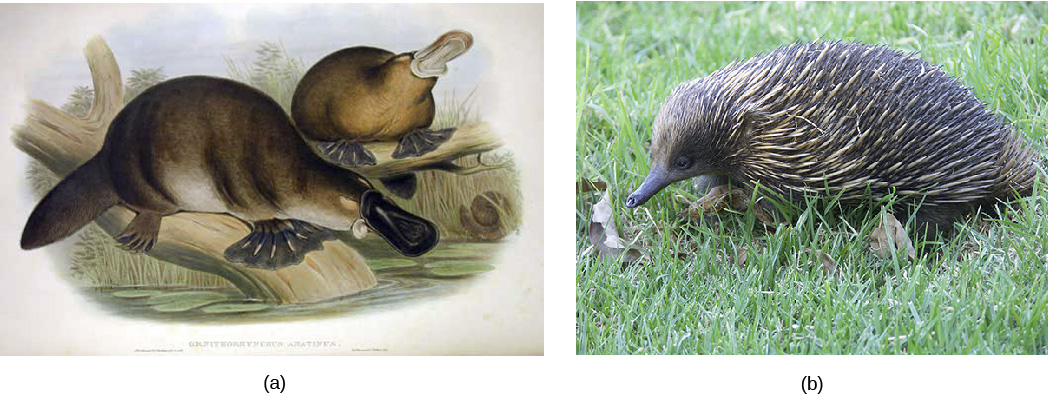
Over 2/3 of the approximately 330 living species of marsupials are constitute in Australia, with the rest, nearly all various types of opossum, found in the Americas, peculiarly South America. Australian marsupials include the kangaroo, koala, bandicoot, Tasmanian devil ((Effigy)), and several other species. Like monotremes, the embryos of marsupials are nourished during a short gestational catamenia (about a month in kangaroos) past a yolk-sac placenta, only with no intervening egg shell. Some marsupial embryos tin enter an embryonic diapause, and filibuster implantation, suspending development until implantation is completed. Marsupial immature are also effectively fetal at birth. Most, but non all, species of marsupials possess a pouch in which the very premature immature reside, receiving milk and continuing their development. In kangaroos, the young joeys go along to nurse for about a year and a half.
A marsupial mammal. The Tasmanian devil is 1 of several marsupials native to Australia. (credit: Wayne McLean)
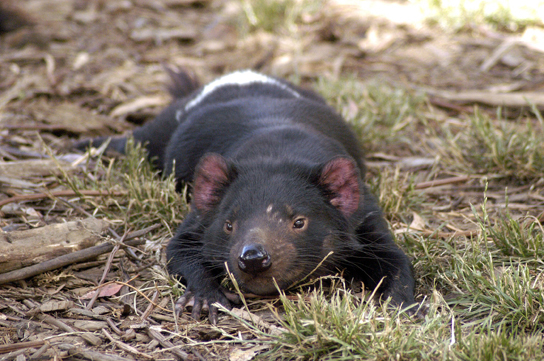
Eutherians (placentals) are the most widespread and numerous of the mammals, occurring throughout the globe. Eutherian mammals are sometimes called "placental mammals" because all species possess a complex chorioallantoic placenta that connects a fetus to the mother, assuasive for gas, fluid, and nutrient exchange. There are about 4,000 species of placental mammals in eighteen to twenty orders with various adaptations for burrowing, flying, swimming, hunting, running, and climbing. In the evolutionary sense, they have been incredibly successful in form, diversity, and abundance. The eutherian mammals are classified in two major clades, the Atlantogenata and the Boreoeutheria. The Atlantogeneta include the Afrotheria (e.thou., elephants, hyraxes, and manatees) and the Xenarthra (anteaters, armadillos, and sloths). The Boreoeutheria comprise two big groups, the Euarchontoglires and the Laurasiatheria. Familiar orders in the Euarchontoglires are the Scandentia (tree shrews), Rodentia (rats, mice, squirrels, porcupines), Lagomorpha (rabbits and hares), and the Primates (including humans). Major Laurasiatherian orders include the Perissodactyla (e.m., horses and rhinos), the Cetartiodactyla (e.g., cows, giraffes, pigs, hippos, and whales), the Carnivora (east.g., cats, dogs, and bears), and the Chiroptera (bats and flying foxes). The two largest orders are the rodents (2,000 species) and bats (about one,000 species), which together constitute approximately threescore per centum of all eutherian species.
Section Summary
Mammals are vertebrates that possess pilus and mammary glands. The mammalian integument includes various secretory glands, including sebaceous glands, eccrine glands, apocrine glands, and mammary glands.
Mammals are synapsids, pregnant that they accept a single opening in the skull behind the eye. Mammals probably evolved from therapsids in the late Triassic menstruum, equally the primeval known mammal fossils are from the early on Jurassic period. A fundamental feature of synapsids is endothermy, and most mammals are homeothermic.
There are three groups of mammals living today: monotremes, marsupials, and eutherians. Monotremes are unique among mammals every bit they lay eggs, rather than giving nativity to young. Marsupials give nascence to very immature young, which typically complete their evolution in a pouch. Eutherian mammals are sometimes called placental mammals, because all species possess a complex placenta that connects a fetus to the female parent, allowing for gas, fluid, and nutrient exchange. All mammals attend their immature with milk, which is derived from modified sweat or sebaceous glands.
Review Questions
Eccrine glands produce ________.
- sweat
- lipids
- scents
- milk
A
Monotremes include:
- kangaroos.
- koalas.
- bandicoots.
- platypuses.
D
The evolution of which of the following features of mammals is hardest to trace through the fossil record?
- Jaw structure
- Mammary glands
- Middle ear construction
- Development of hair
B
Disquisitional Thinking Questions
Describe three unique features of the mammalian skeletal organization.
The lower jaw of mammals consists of simply one bone, the dentary. The dentary os joins the skull at the squamosal bone. Mammals have iii bones of the middle ear. The adductor muscle that closes the jaw is composed of two muscles in mammals. Nigh mammals have heterodont teeth.
Draw three characteristics of the mammalian encephalon that differ from other vertebrates.
In some mammals, the cerebral cortex is highly folded, allowing for greater surface surface area than a smooth cortex. The optic lobes are divided into two parts in mammals. Eutherian mammals also possess a specialized structure that links the two cerebral hemispheres, chosen the corpus callosum.
How did the evolution of jaw musculature allow mammals to spread?
The muscles that close the jaw in mammals evolved to allow chewing to occur. Chewing meant mammals could now grind nutrient with their teeth (molars), allowing them to eat a more than diverse diet. This would have protected them in the event of a mass extinction (withal accept food sources available) and allow them to colonize new environments (consume new nutrient sources). Chewing also allowed mammals to break down nutrient into smaller pieces to speed digestion, reducing the fourth dimension between consumption and free energy extraction.
Glossary
- apocrine gland
- aroma gland that secretes substances that are used for chemical communication
- dentary
- single bone that comprises the lower jaw of mammals
- diphyodont
- refers to the possession of ii sets of teeth in a lifetime
- eccrine gland
- sweat gland
- eutherian mammal
- mammal that possesses a complex placenta, which connects a fetus to the female parent; sometimes called placental mammals
- heterodont tooth
- different types of teeth that are modified for different purposes
- mammal
- one of the groups of endothermic vertebrates that possesses hair and mammary glands
- mammary gland
- in female mammals, a gland that produces milk for newborns
- marsupial
- one of the groups of mammals that includes the kangaroo, koala, bandicoot, Tasmanian devil, and several other species; young develop inside a pouch
- monotreme
- egg-laying mammal
- Ornithorhynchidae
- clade that includes the duck-billed platypus
- sebaceous gland
- in mammals, a pare gland that produce a lipid mixture called sebum
- Tachyglossidae
- clade that includes the echidna or spiny anteater
Source: https://opentextbc.ca/biology2eopenstax/chapter/mammals/
Posted by: bryantderstly.blogspot.com

0 Response to "Which Of The Following Are Distinguishing Features Of Mammals From Other Animals?"
Post a Comment